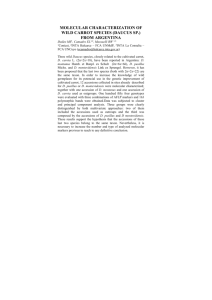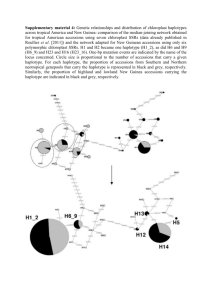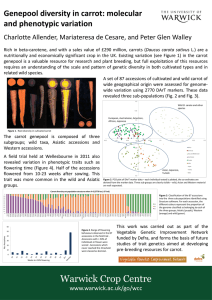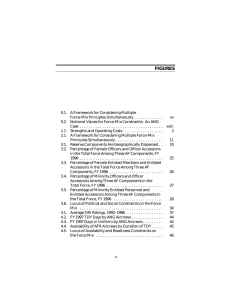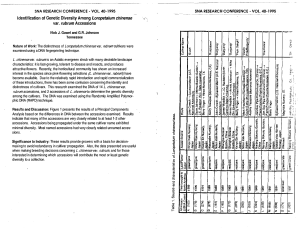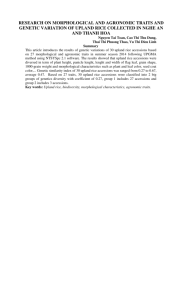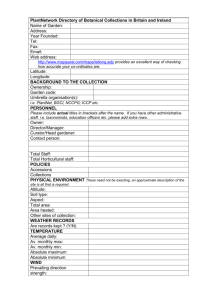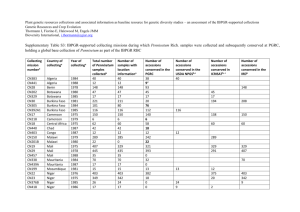Asian Journal of Agricultural Sciences 7(4): 36-44, 2015
advertisement
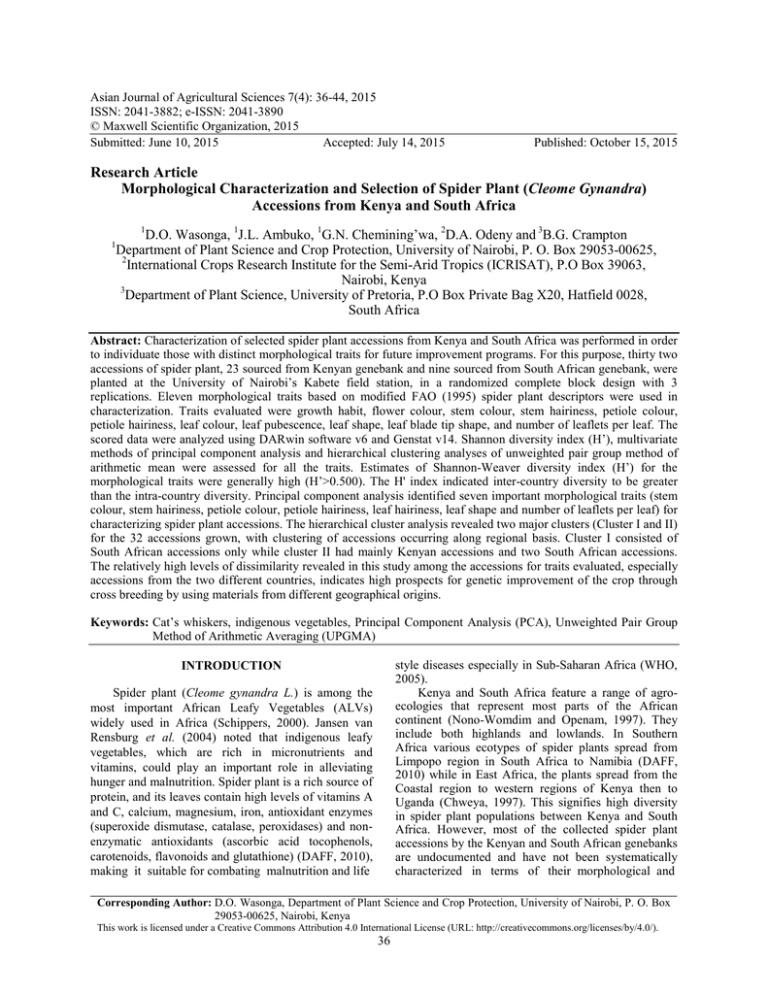
Asian Journal of Agricultural Sciences 7(4): 36-44, 2015 ISSN: 2041-3882; e-ISSN: 2041-3890 © Maxwell Scientific Organization, 2015 Submitted: June 10, 2015 Accepted: July 14, 2015 Published: October 15, 2015 Research Article Morphological Characterization and Selection of Spider Plant (Cleome Gynandra) Accessions from Kenya and South Africa 1 1 D.O. Wasonga, 1J.L. Ambuko, 1G.N. Chemining’wa, 2D.A. Odeny and 3B.G. Crampton Department of Plant Science and Crop Protection, University of Nairobi, P. O. Box 29053-00625, 2 International Crops Research Institute for the Semi-Arid Tropics (ICRISAT), P.O Box 39063, Nairobi, Kenya 3 Department of Plant Science, University of Pretoria, P.O Box Private Bag X20, Hatfield 0028, South Africa Abstract: Characterization of selected spider plant accessions from Kenya and South Africa was performed in order to individuate those with distinct morphological traits for future improvement programs. For this purpose, thirty two accessions of spider plant, 23 sourced from Kenyan genebank and nine sourced from South African genebank, were planted at the University of Nairobi’s Kabete field station, in a randomized complete block design with 3 replications. Eleven morphological traits based on modified FAO (1995) spider plant descriptors were used in characterization. Traits evaluated were growth habit, flower colour, stem colour, stem hairiness, petiole colour, petiole hairiness, leaf colour, leaf pubescence, leaf shape, leaf blade tip shape, and number of leaflets per leaf. The scored data were analyzed using DARwin software v6 and Genstat v14. Shannon diversity index (H’), multivariate methods of principal component analysis and hierarchical clustering analyses of unweighted pair group method of arithmetic mean were assessed for all the traits. Estimates of Shannon-Weaver diversity index (H’) for the morphological traits were generally high (H’>0.500). The H' index indicated inter-country diversity to be greater than the intra-country diversity. Principal component analysis identified seven important morphological traits (stem colour, stem hairiness, petiole colour, petiole hairiness, leaf hairiness, leaf shape and number of leaflets per leaf) for characterizing spider plant accessions. The hierarchical cluster analysis revealed two major clusters (Cluster I and II) for the 32 accessions grown, with clustering of accessions occurring along regional basis. Cluster I consisted of South African accessions only while cluster II had mainly Kenyan accessions and two South African accessions. The relatively high levels of dissimilarity revealed in this study among the accessions for traits evaluated, especially accessions from the two different countries, indicates high prospects for genetic improvement of the crop through cross breeding by using materials from different geographical origins. Keywords: Cat’s whiskers, indigenous vegetables, Principal Component Analysis (PCA), Unweighted Pair Group Method of Arithmetic Averaging (UPGMA) style diseases especially in Sub-Saharan Africa (WHO, 2005). Kenya and South Africa feature a range of agroecologies that represent most parts of the African continent (Nono-Womdim and Openam, 1997). They include both highlands and lowlands. In Southern Africa various ecotypes of spider plants spread from Limpopo region in South Africa to Namibia (DAFF, 2010) while in East Africa, the plants spread from the Coastal region to western regions of Kenya then to Uganda (Chweya, 1997). This signifies high diversity in spider plant populations between Kenya and South Africa. However, most of the collected spider plant accessions by the Kenyan and South African genebanks are undocumented and have not been systematically characterized in terms of their morphological and INTRODUCTION Spider plant (Cleome gynandra L.) is among the most important African Leafy Vegetables (ALVs) widely used in Africa (Schippers, 2000). Jansen van Rensburg et al. (2004) noted that indigenous leafy vegetables, which are rich in micronutrients and vitamins, could play an important role in alleviating hunger and malnutrition. Spider plant is a rich source of protein, and its leaves contain high levels of vitamins A and C, calcium, magnesium, iron, antioxidant enzymes (superoxide dismutase, catalase, peroxidases) and nonenzymatic antioxidants (ascorbic acid tocophenols, carotenoids, flavonoids and glutathione) (DAFF, 2010), making it suitable for combating malnutrition and life Corresponding Author: D.O. Wasonga, Department of Plant Science and Crop Protection, University of Nairobi, P. O. Box 29053-00625, Nairobi, Kenya This work is licensed under a Creative Commons Attribution 4.0 International License (URL: http://creativecommons.org/licenses/by/4.0/). 36 Asian J. Agric. Sci., 7(4): 36-44, 2015 agronomic variability, which would be important for breeding and conservation (K’opondo et al., 2009; Maundu et al., 1999; Chweya and Mnzava, 1997). Previous studies on the diversity of spider plant focusing on morpho-agronomic differences, for example plant height, plant structure and 50% flowering, have evaluated few accessions with only few traits used in characterization (Masuka and Mazarura, 2012; K’Opondo, 2011). The studies further recommend use of more accessions and characters under field environments to characterize spider plant diversity. Currently, the identification of these accessions relies on local names, and often, an accession’s name may represent several genotypes. Like any other crop species, the first step in spider plant improvement is assessment of local materials, including collection and evaluation of phenotypic trait expressions. The objective of this study was to evaluate the phenotypic diversity among Kenyan and South African accessions of spider plant. were carried out in two seasons (September 2013 to March February 2013 and March 2014 to June 2014). Accessions planted were pre-germinated for 72 hours under treatment with 0.2% Gibberellic Acid (GA) purchased from Marty Chemical (KE) supplies. Well decomposed chicken manure was applied to rows and mixed with soil before planting at 60g/line. Top dressing was done with 12 g of calcium ammonium nitrate/ per line (26%N) (80 kg/Nha). The plants were sprayed using an organophosphate insecticide duduthrin (lambdacyhalothrin-250EC), purchased from Twiga Chemicals Industries, at the rate of 65 mL/ 20 L of water to kill cutworms and aphids after emergence and before flowering to prevent insect damage. The plants were kept weed free throughout the experimental period by hand weeding. The experiment was conducted under rainfed conditions. However, supplemental irrigation was applied two times, at two weeks after planting and two weeks after flower initiation. Parameters measured: Data were collected from accessions that survived till maturity and harvest. Qualitative variables were scored on individual plant basis, using three randomly selected plants per plot. A list of modified spider plant descriptors from the Food and Agriculture Organization (FAO, 1995) was used as a guide in the selection of parameters and procedures for characterization. Qualitative characters scored included growth habit, flower colour, stem colour, stem hairiness, petiole color, petiole hairiness, leaf colour, leaf pubescence, leaf shape, leaf blade tip shape, and number of leaflets per leaf (Table 1). Dissimilarities were estimated based on Euclidean distance matrix and hierarchical clustering analyses of unweighted pair group method of arithmetic mean was performed in DARwin 5.0 software as described by Perrier and Jacquemud-Collet (2006). The Clusters and relationships were displayed as a phenogram and were used to assist in grouping and selecting accessions with promising characters out of which those with high performing traits were selected. Multivariate-Principal Component Analysis (PCA) was conducted between variance-covariance matrix using Genstat software programme, version 14 (Payne et al., 2011) to identify the most significant descriptors in capturing the phenotypic variation in the spider plants. MATERIALS AND METHODS Experimental materials: Thirty two spider plant accessions collected from different eco-regions in Kenya and South Africa were used in the study. The accessions were obtained from National Genebanks of the respective countries hence no exploration work for the source of the planting materials. Study site: The experiment was conducted at the University of Nairobi’s Kabete Field station farm, Kenya (1°15’S, 36°44’ E, and 1940 m above sea level). The site is located in Upper Midland Zone three with an annual rainfall of 700-1500 mm and average temperatures of 13-23°C. Experimental design and management: Randomized complete block design was used. The experimental field was ploughed and harrowed with a tractor. The field was lined and pegged and divided into blocks replicated three times. Each accession was planted in two rows of 20 seeding holes (ten plants in a row) in a plot. Row plots were 3 m in length with inter-row spacing of 30 cm and intra-row spacing of 30 cm. The experiments Table 1: Character, descriptor and codes used for characterization of qualitative traits in spider plant accessions used in the study Character Descriptor and code Growth habit Erect (2), semi-erect (4) and prostrate (6) Flower colour White (1), purple (2) and pink (3) Stem colour Green (1), pink (2), violet (3) and purple (4) Stem hairiness Glabrous (1), weak/sparse (3), medium (5) and profuse (7) Petiole colour Green (1), pink (2), violet (3) and purple (4), Petiole hairiness Glabrous (1), weak/sparse (3), medium (5) and profuse (7) Leaf colour Dark green (1), light green (2), Leaf hairiness Glabrous (1), weak/sparse (3), medium (5) and profuse (7) Leaf shape Linear (1), lanceolate (2), elliptic (3), obovate (4) and ovate (5) Leaf blade tip shape Acuminate (1), acute (2), obtuse (3) and cuspidate (4) No. of leaflets per leaf Three (1), four (2), five (3), six (4) and seven (5) Food and Agriculture Organization of the United Nations (FAO, 1995); Numbers in brackets on the right-hand side are the corresponding descriptor codes listed in the FAO publication with modifications during the development of the list 37 Asian J. Agric. Sci., 7(4): 36-44, 2015 Table 2: List of Kenyan and South African spider plant accessions evaluated in the study I S/no. Accession no. Species name Region County/area AEZ 1 1959 Za Cleome gynandra Mpumalanga Loopspruit SH 2 1988 Za Cleome gynandra Mpumalanga Silverhills SH Za 3 2000 Cleome gynandra Mpumalanga Gemsbokspruit SH Za 4 2232 Cleome gynandra Northern province Arthurstone SA 5 2241 Za Cleome gynandra Northern province Arthurstone SA 6 2249 Za Cleome gynandra Northern province Arthurstone SA Za 7 2279 Cleome gynandra Northern province Arthurstone SA Za 8 2289 Cleome gynandra Mpumalanga Rooikoppen SH 9 2299 Za Cleome gynandra Mpumalanga Loding SH 10 GBK-027131Ke Cleome gynandra Rift valley Elgeyo Marakwet LH 3 Ke 11 GBK-027195 Cleome gynandra Rift valley Keiyo Marakwet LM 1 Ke 12 GBK-027212 Cleome gynandra Rift valley Keiyo Marakwet LH 2 13 GBK-028554 Ke Cleome gynandra Nyanza Siaya LM 1 14 GBK-031990 Ke Cleome gynandra Western Busia LH 2 Ke 15 GBK-031992 Cleome gynandra Western Busia LM 3 Ke 16 GBK-031993 Cleome gynandra Western Busia LM 1 17 GBK-031996 Ke Cleome gynandra Western Busia LM 1 18 GBK-031997 Ke Cleome gynandra Western Busia LM 3 Ke 19 GBK-032134 Cleome gynandra Eastern Makueni UM 4 Ke 20 GBK-032253 Cleome gynandra Rift valley West Pokot UM 5 21 GBK-032302 Ke Cleome gynandra Western Mbale LM 1 22 GBK-040606 Ke Cleome gynandra Rift valley Elgeyo Marakwet LH 3 Ke 23 GBK-043261 Cleome gynandra Rift valley Nandi LH 1 Ke 24 GBK-043760 Cleome gynandra Rift valley Koibatek LH 2 25 GBK-045408 Ke Cleome gynandra Western Vihiga LM 1 26 GBK-045426 Ke Cleome gynandra Western Vihiga LM 1 Ke 27 GBK-045436 Cleome gynandra Nyanza Kisumu LM 3 Ke 28 GBK-045446 Cleome gynandra Nyanza Kisii LH 1 29 GBK-045451 Ke Cleome gynandra Central Kiambu UH 1 30 GBK-045456 Ke Cleome gynandra Central Kiambu UH 1 Ke 31 GBK-045494 Cleome gynandra Coast Kilifi L2 Ke 32 GBK-045497 Cleome gynandra Coast Kilifi L2 I Refers to identifier code used to identify an accession in the collection at genebank in Kenya and South Africa; Ke Refers to Kenyan accession; Za refers to South African accession; AEZ: agroecological zone; LH: lower highland; LM: lower middle land; UM: upper middle land; UH: upper highland; L: lowland; SH: sub-humid; SA: semi-arid RESULTS AND DISCUSSION The existence of morphological types among the spider plant accessions (Table 2) was evident as there were variations in forms and features of the different character traits measured and evaluated. Growth habit: It was observed that 84.4% of the accessions studied produced an erect growth habit with 15.6% showing semi-erect growth habit (Fig. 1). Accessions with semi-erect growth habit were 1988, 2000, GBK-028554, GBK-045436 and GBK-045494. The Food and Agriculture Organization FAO (1995) descriptor describes three main growth habits in spider plants. These are erect, semi-erect and prostrate. However, in this study only two of these growth habits were found as was also observed by Chigumira (2004). This may be attributed to the fact that the FAO report was based on assessment of large number of spider plant accessions collected from many parts of the world as compared to this study where the assessment was based on only a small number of spider plant accessions from Kenya and South Africa. Growth habit is very important in the cropping system of spider plant and an influential character in harvesting of the plant (Mnzava, 1997). The semi-erect types could be used by peasant Fig. 1: Frequency distri1bution of growth habit of spider plant accessions farmers in mixed cropping while the erect types are good for intercrop adaptability (Masuka and Mazarura, 2012). According to K’opondo (2011) the erect spider plant accessions have high reproductive efficiency while the semi-erect ones have higher total pod yield. This attribute was also observed in this study. Flower colour and stem characteristics: The observed flower colours of the accessions used in this study are presented in Fig. 2. About 46.8% of the 38 Asian J. Agric. Sci., 7(4): 36-44, 2015 Stem colour of the accessions was mainly purple (50%) and green (40.6%) while only 9.4% of the stems were violet in colour (Fig. 3). Proportion of accessions with white flowers and green stems were 73.4% while those with white flowers and purple stems were 13.3%. White flowers and violet stems accounted for 13.3% of the accessions. Accessions with white flowers had mostly green stems and green petiole (66.7%) while purple flowered accessions with purple stems and purple petiole were 22.2%. Pink flowered accessions were noted to have 10% violet stems and 90% purple stems. The proportion of accessions characterized with pink petioles was 37.5%, green petioles 37.5%, purple petiole pigmentation 18.8%, and violet petioles 6.2% (Fig. 3). The polymorphism in colour observed in flowers, stems and petioles which ranged from violet, pink and purple is due to the accumulation of anthocyanins in the plant tissues. Anthocyanins are glycosides and acylglycosides of anthocyanids and belong to the general class of flavanoids (Dasgupta and De, 2007). These plant pigments are responsible for a variety of red, blue, and purple colours in fruits and vegetables. These pigments which occur in flowers are very useful to plants and have been reported to play key role in pollination and subsequent fruit production (Dasgupta and De, 2007). These plant pigments have antiinflamatory, antitumor, antioxidant, and antihepatotoxic properties in human (Opole et al., 1995). The accumulation of these anthocyanins in plant tissues are environmentally controlled by factors such as temperature, nutrients, and heat stress. Hence ability by the spider plant ecotypes to grow under diverse environmental conditions is enhanced in those ecotypes that have anthocyanin accumulation on both stems and petioles rather on either stem or petiole only, or even no accumulation on both the plant parts (K’opondo, 2011). Stem hairiness for the study accessions was mainly profuse 56.2%, while medium and glabrous accounted for 21.9% each (Fig. 4). Glabrous accessions were mainly South African accessions. Petiole hairiness varied from medium (37.5%), to sparse (31.2%), glabrous (18.8%) and profuse (12.5%) as shown in Fig. 4. The study revealed that green stem accessions were mostly glabrous in stems and petioles compared to the purple stem accessions which had profuse pubescence on stems and petioles. This observation was in conformity with the findings of Makgakga (2011), who reported that purple stemmed plants are usually more glandular than green stemmed plants. The Kenyan purple stem accessions were significantly different from most of the South African accessions except for South African accessions 1959, 2289 and 2232. According to Imbamba (1976), leaf, stem and petiole hairs are mostly pronounced in plants growing in the field. Plants derive Fig. 2: Frequency distribution of flower colour of spider plant accessions Fig. 3: Frequency distribution of stem colour and petiole colour of spider plant accessions accessions produced white flowers, 31.3% produced pink flowers and 21.9% produced purple flowers. Masuka and Mazarura (2012) made a similar observation on 4 accessions they studied. Three (3) accessions had white flowers while 1 accession had purple flower. The results of the present study showed all three flower colours documented by FAO (1995). In contrast, studies done by AVRDC (2009), reported additional flower colours such as mauve-pink, lilacpink and violet. This may be attributed to varying environmental factors such as temperature, nutrients and stress where the evaluations were conducted. 39 Asian J. Agric. Sci., 7(4): 36-44, 2015 Fig. 5: Frequency distribution of leaf shape and of leaf blade tip shape of spider plant accessions Fig. 4: Frequency distribution of stem and petiole hairiness of spider plant accessions The proportion of leaf hairiness of the study accessions ranged from sparse (50%), glabrous (28.1%), medium (18.8%), and profuse (3.1%) (Fig. 6). The number of leaflets per leaf were mostly five (81.3%) but three (3.1%), six (6.3%) and seven (9.4%) leaflets per leaf were also noted in other accessions (Fig. 6). several advantages from these hairs. They interfere with the feeding by herbivores due to stiffness and irritability to the palate. In windy locations, hairs break up the flow of air across the plant surface, reducing transpiration. Dense coatings of hairs reflect sunlight, protecting the more delicate tissues underneath in hot, dry, open habitats. This explains why most of the study accessions in the field had profuse hairs on leaves, stems and petioles. The more profuse Kenyan accessions are thus better adapted with regards to this character compared to the glabrous South African accessions. However, the glabrous accessions are preferred for consumption due to their higher ease of palatability. Cluster analysis: The phenogram generated using eleven morphological descriptors based on Euclidean Distance Coefficient and Unweighted Pair Group Method of Arithmetic mean (UPGMA) clustering method (Fig. 7) clearly showed the phenetic relationship among the accessions. The phenogram separated the 32 accessions into two major clusters (Cluster I and II) by grouping accessions sharing close phenotypic similarities into distinct clusters. Cluster I had seven accessions while cluster II had 27 accessions. Cluster I had South African accessions while cluster II mainly had Kenyan accessions and two South African accessions (2289 and 1959). Within country variation was observed for both the Kenyan and South African accessions with accessions collected from the same region closely related. Cluster I shows a close relationship between South African accessions 2249 and 2232 which were collected from Northern Province. Likewise, accessions 1988 and 2000 which Leaf characteristics: The basal leaf shape for the study accessions varied from elliptic (43.8%) to ovate (28.1%) to lanceolate (15.6%) and obovate (12.5%) as shown in Fig. 5. Leaf blade tip shapes for the study accessions ranged from obtuse (43.8%), acute (28.1%), acuminate (15.6%), and cuspidate (12.5%). while leaf colour was either dark green (50%) or light green (50%). 40 Asian J. Agric. Sci., 7(4): 36-44, 2015 Fig. 6: Frequency distribution of leaf hairiness and of number of leaflets/leaf of spider plant accessions Fig. 7: UPGMA cluster analysis phenogram showing the relationship among the 32 spider plant accessions grown in the field were collected from Mpumalanga region had similar clades suggesting a close resemblance in their qualitative traits. However, the South African accessions collected from different regions expressed dissimilarity in variations as was the case with accessions 2299, 2241 and 2279 in cluster I Fig. 7. Accession 2299 which was collected from Mpumalanga region had a longer genetic distance from the other two accessions, 2241 and 2279 which were collected from Northern Province. Within country variation was also observed in the Kenyan accessions. In sub-cluster ‘c’ of three accessions originating from one node, two accessions GBK045426, GBK05408 from western region had a closer connection than to accession GBK045456 which was collected from central Kenya. Similarly, accession GBK031997 and GBK031996 in sub-cluster ‘d’ which were collected from western region, were more closely related than to accession GBK040606 which was collected from Rift valley region. However, in cluster II 41 Asian J. Agric. Sci., 7(4): 36-44, 2015 Table 3: Eigenvaluesa, eigenvectorsb and percentage of variation explained by the first six principal components for the 32 spider plant accessions Principal component -----------------------------------------------------------------------------------------------------------------------------------------1 2 3 4 5 6 Qualitative character Variation explained (%) 70.92 6.860 6.220 4.440 3.090 2.650 Eigenvalue 17.16 1.660 1.510 1.080 0.750 0.640 Growth habit -0.056 -0.003 -0.081 0.089 -0.328 -0.282 Flower color 0.110 0.072 -0.360 0.322 0.176 0.350 Stem color 0.279 0.319 -0.092 0.154 0.756 -0.234 c 0.653 0.118 -0.565 -0.198 -0.357 -0.011 Stem hairiness Petiole color 0.160 0.307 0.337 0.691 -0.251 0.207 Petiole hairiness 0.500 -0.039 0.464 -0.016 -0.053 -0.539 Leaf color -0.075 -0.069 0.032 -0.091 0.072 -0.180 Leaf hairiness 0.419 -0.326 0.403 -0.247 0.087 0.572 Leaf shape -0.045 0.667 0.171 -0.485 0.048 0.205 Leaf blade tip shape -0.145 0.356 0.117 -0.171 -0.193 -0.058 No leaflets per leaf 0.031 0.317 0.045 0.115 -0.211 0.074 a Eigenvalues indicate the amount of variance explained by each principal component; bEigenvectors are the weights in a linear transformation when computing principal components; cValues in bold indicate the most relevant descriptors that contributed most to the particular component sub-cluster ‘b’, accessions GBK031993 and GBK027195 which were from Western and Rift valley regions respectively expressed a close connection despite being collected from the two different regions. This could be attributed to the possibility of seed trade among the farmers from the two regions which border one another. The clustering pattern shows that accessions from Kenya were genetically more distant from each other and from the South African accessions. This indicates a difference in the genetic makeup of the two accession groupings (K’opondo, 2011). The findings also reveal that most accessions used in this study were grouped according to their geographic origin. The similarity observed between the collection regions and genetic diversity of the accessions explained a slim variability among the accessions from the same collection areas for most of the characters. This close resemblance indicates the possibility that the accessions in each collection region may have come from similar genetic backgrounds. High levels of similarity have been detected among spider plant genotypes based on analysis of seed proteins (K’opondo et al., 2009). The high level of relationship reported among spider plant accessions may also be due to it being a self-pollinated crop (Omondi, 1990). Furthermore, genetic distance was observed among the accessions from the two major geographical regions (Kenya and South Africa), presenting a great possibility for the development of suitable varieties for the various agroecological zones of Africa with different agro-climatic conditions. The clustering pattern of accessions obtained in phenogram was further investigated through Principal Component Analysis (PCA) to determine the relationship between plant traits and accessions. It indicated set of traits that caused clustering of accessions into specific groups and that most effectively discriminated between accessions. The percentage variation explained by the first six Principal Components (PC) and the vector loadings for each character and PC are presented in Table 3. The first six PCs explained 94.2% of the total variation among the study accessions. Stem hairiness and petiole hairiness were the main traits that contributed positively to PC1. It was also observed that growth habit, leaf colour, leaf shape and leaf blade tip shape had negative loadings to this component at -0.056, -0.075, -0.045 and -0.145, respectively. Leaf shape was the most important character that contributed to the second principal component in field grown accessions. All characters that made significant contributions to a particular principal component were important contributors to another principal component. Multivariate principal component analysis has been previously used to identify the most important traits for characterizing genotypes and accessions of different species including pigeonpea (Upadhyaya et al., 2007), sweetpotato (Yada et al., 2010) and wheat (Al Khanjari et al., 2008). In the present study, PCA identified six characters which were stem colour, stem hairiness, petiole colour, petiole hairiness, leaf hairiness and leaf shape. Future collections and characterization to broaden the Kenyan and South African spider plant resource base could focus on the characters identified above. CONCLUSION A range of observations was made in the current analyses of phenotypic diversity of spider plant using both their qualitative traits. In overall, relatively high level of dissimilarity was observed among the accessions for most of the traits evaluated, especially accessions from the two different countries. This indicates better possibilities for genetic improvement of the crop through selection and cross breeding. However, a comparatively high level of similarity was revealed between accessions from the same region for most of the characters studied. The use of materials from different geographical origins in any cross breeding programme aiming to develop suitable varieties with specific characters is therefore strongly recommended. This would avoid the use of material 42 Asian J. Agric. Sci., 7(4): 36-44, 2015 Chigumira, N.F., 2004. In: Grubben, G.J.H. and O.A. Denton (Eds.), Plant Resources of Tropical Africa 2: Vegetables. PROTA Foundation/Backhuys Publishers, CTA Wageningen, Netherlands, pp: 192. Dasgupta, N. and B. De, 2007. Antioxidant activity of some leafy vegetables of India: A comparative study. Food Chem., 101: 471-474. DAFF (Department of Agriculture Forestry and Fisheries), 2010. Cleome. Resource Centre, Pretoria, South Africa. FAO (Food and Agricultural Organisation), 1995. Production Year Book. FAO, Rome, Italy. Imbamba, S.K., 1976. The influence of light and temperature on photosynthesis and transpiration in some Kenyan plants. Plant Physiol., 57: 106-109. Jansen van Rensburg, W.S., S.L. Venter, T.R. Netshiluvhi, E. van Den Heever, H.J. Voster and J.A. Ronde, 2004. Role of indigenous leafy vegetables in combating hunger and malnutrition. South African J. Botany, 70: 52-59. K’Opondo, F.B.O., H.A. van Rheene and R.M. Muasya, 2009. Assessment of genetic variation of selected spider plant (Cleome gynandra L.) morphotypes from Western Kenya. African J. Biotechnol., 8: 4325-4332. K’Opondo, F.B.O., 2011. Morphological characterization of selected Cleome gynandra types from Western Kenya. Ann. Biol. Res., 2(2): 54-64. Maundu, P.M., G.W. Ngugi and C.H.S. Kabuye, 1999. Traditional food plants of Kenya. KENRIK National Museums of Kenya, Nairobi, Kenya, pp: 270. Makgakga, C., 2011. Cleome Gynandra. Retrieved from: www.plantzafrica.com, (Accessed on: April 13, 2014). Masuka, A. and U. Mazarura, 2012. Morphological characterization of four selected spider plant (Cleome gynandra L.) morphs from Zimbabwe and Kenya. Asian J. Agric. Rural Dev., 2(4): 646-657. Mnzava, N.A., 1997. Vegetable Crop Diversification and the Place of Traditional Species in the Tropics. In: Guarino, L. (Ed.), Traditional African Vegetables. Proceedings of the IPGRI International Workshop on Genetic Resources of Traditional Vegetables in Africa: Conservation and Use. ICRAF-HQ, Nairobi, Kenya. IPGRI, Rome, August 29-31, pp: 1-15. Nono-Womdim, R. and R.T. Openam, 1997. Scope and highlights of research on indigenous vegetables of Southern and East Africa. In: Schippers, R. and L. Budd (Eds.), Proceedings of a Workshop on African Indigenous Vegetables, Limbe, Cameroon. ODA/NRI/IPGRI. Omondi, C.O., 1990. Variation and yield prediction analyses of some morphological traits in six kenyan landraces population of spider flower (Gynandropsis gynandra (L.). MSc. Thesis, University of Nairobi, Kenya. with a similar genetic background, as well as avoiding spending time, money and other resources on materials not having the best chance to produce the best result. For example, the use of accession GBK027212 (from Kenya) in a breeding programme aiming to improve accession 1959 (from South Africa) for leaf size and the yield of seeds per plant is likely to have a better chance of success than the use of accession 2289 from the same region. This study also revealed that some morphological traits discriminated more efficiently between the accessions than others. It would therefore be very important to identify beforehand the morphological characters with a high discrimination capacity before undertaking any genetic diversity studies based on morphological traits. RECOMMENDATIONS In contrast to morphological traits, molecular markers can reveal abundant difference among genotypes at the DNA level, providing a more direct, reliable and efficient tool for germplasm characterization, conservation and management, and untouched by environmental influence. ACKNOWLEDGMENT The author thanks the National Commission of Science, Technology and Innovation (NACOSTI), and the National Research Foundation (NRF) for sponsoring this research study. Much appreciation to the National Genebank of Kenya and South African Genebank for availing the spider plant accessions used in this study. REFERENCES Al Khanjari, S., A.A. Filatenko, K. Hammer and A. Buerkert, 2008. Morphological diversity of Omani wheat. Genet. Resour. Crop Evol., 46: 419-425. AVRDC, 2009. Spider Plant: An Indigenous Species with Many Uses. The World Vegetable Centre, Arusha Tanzania. Chweya, J.A., 1997. Genetic Enhancement of Indigenous Vegetables in Kenya. In: Guarino, L. (Ed.), Traditional African Vegetables: Promoting the Conservation and Use of Underutilized and Neglected Crops. Proceedings of the IPGRI International Workshop on Genetic Resources of Traditional Vegetables in Africa: Options for Conservation and Use, ICRAF-HQ, Nairobi, Kenya. Institute of Plant Genetics and Crop Plant Research, Gatersleben/IPGRI, Rome Italy, pp: 29-31. Chweya, J.A. and N.A. Mnzava, 1997. Cat’s whiskers, spider plant L. Promoting the conservation and use of underutilized and neglected crops. Institute of Plant Genetics and Crop Plant Research, Gatersleben/International Plant Genetic Resources Institute, Rome, Italy. 43 Asian J. Agric. Sci., 7(4): 36-44, 2015 Opole, M., J. Chweya and J. Imungi, 1995. Indigenous vegetables of Kenya: Indigenous knowledge, Agronomy and nutritive value. Field and Laboratory Experience Report. Payne, R.W., D.A. Murray, S.A. Harding, D.B. Baird and D.M. Soutar, 2011. An Introduction to GenStat for Windows, 14th Edn., VSN International, Hemel Hempstead, UK. Perrier, X. and J.P. Jacquemud-Collet, 2006. DARwin Software. Retrieved from: http://darwin.cirad. fr/darwin. Schippers, R.R., 2000. African Indigenous Vegetables: An Overview of the Cultivated Species. Natural Resources Institute/ACP-EU Technical Centre for Agricultural and Rural Cooperation, Chatham, UK, pp: 214. Upadhyaya, H.D., K.N. Reddy, C.L.L. Gowda and S. Singh, 2007. Phenotypic diversity in the pigeon pea (Cajanus cajan) core collection. Genet. Resour. Crop Evol., 54: 1167-1184. WHO, 2005. Micronutrient Deficiency Information System Working Paper No. 2. World Health Organization, Geneva, Switzerland, pp: 1-116. Yada, B., P. Tukamuhabwa, A. Ajao and R.O. Mwanga, 2010. Morphological characterization of Ugandan sweetpotato germplasm. Crop Sci., 50: 2364-2371. 44
